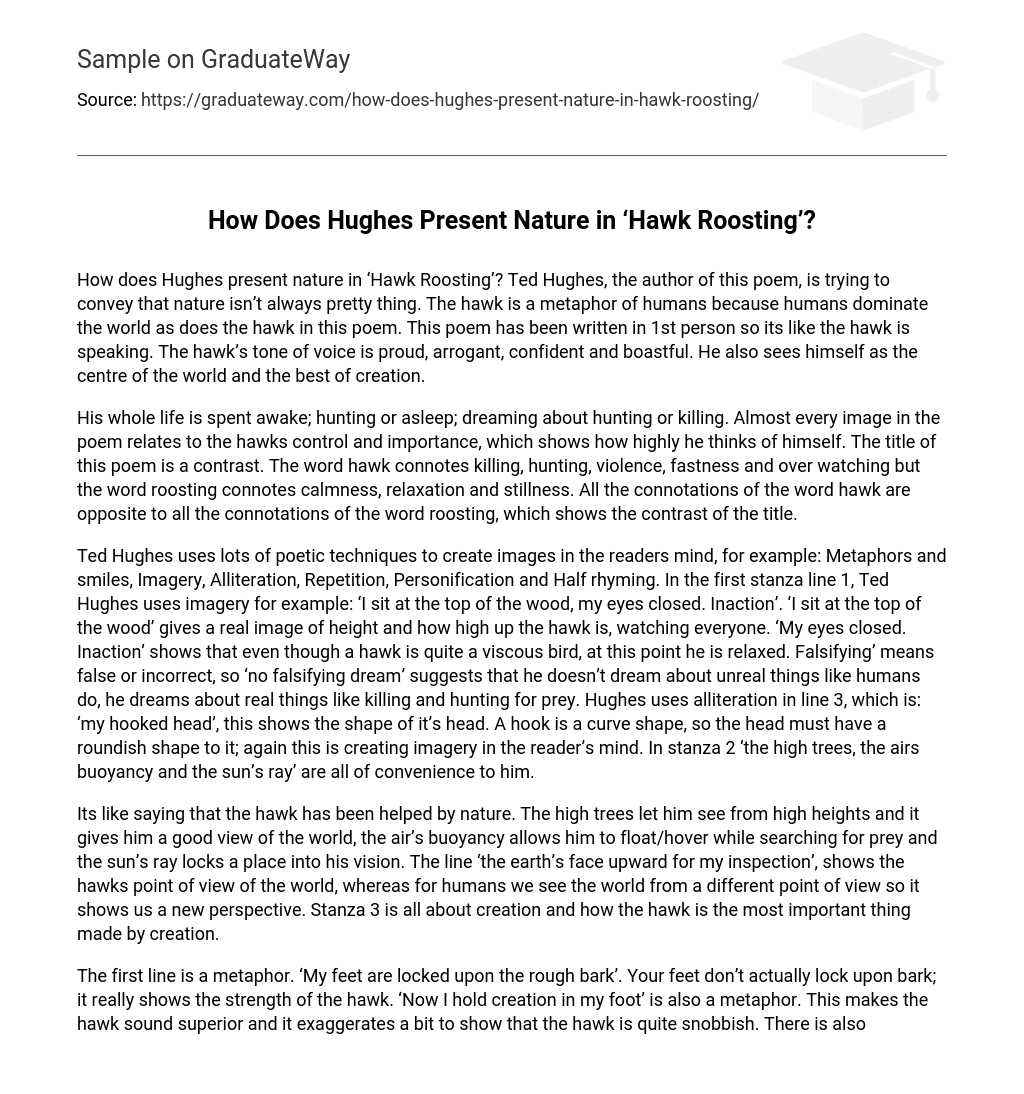How does Hughes present nature in ‘Hawk Roosting’? Ted Hughes, the author of this poem, is trying to convey that nature isn’t always pretty thing. The hawk is a metaphor of humans because humans dominate the world as does the hawk in this poem. This poem has been written in 1st person so its like the hawk is speaking. The hawk’s tone of voice is proud, arrogant, confident and boastful. He also sees himself as the centre of the world and the best of creation.
His whole life is spent awake; hunting or asleep; dreaming about hunting or killing. Almost every image in the poem relates to the hawks control and importance, which shows how highly he thinks of himself. The title of this poem is a contrast. The word hawk connotes killing, hunting, violence, fastness and over watching but the word roosting connotes calmness, relaxation and stillness. All the connotations of the word hawk are opposite to all the connotations of the word roosting, which shows the contrast of the title.
Ted Hughes uses lots of poetic techniques to create images in the readers mind, for example: Metaphors and smiles, Imagery, Alliteration, Repetition, Personification and Half rhyming. In the first stanza line 1, Ted Hughes uses imagery for example: ‘I sit at the top of the wood, my eyes closed. Inaction’. ‘I sit at the top of the wood’ gives a real image of height and how high up the hawk is, watching everyone. ‘My eyes closed. Inaction’ shows that even though a hawk is quite a viscous bird, at this point he is relaxed. Falsifying’ means false or incorrect, so ‘no falsifying dream’ suggests that he doesn’t dream about unreal things like humans do, he dreams about real things like killing and hunting for prey. Hughes uses alliteration in line 3, which is: ‘my hooked head’, this shows the shape of it’s head. A hook is a curve shape, so the head must have a roundish shape to it; again this is creating imagery in the reader’s mind. In stanza 2 ‘the high trees, the airs buoyancy and the sun’s ray’ are all of convenience to him.
Its like saying that the hawk has been helped by nature. The high trees let him see from high heights and it gives him a good view of the world, the air’s buoyancy allows him to float/hover while searching for prey and the sun’s ray locks a place into his vision. The line ‘the earth’s face upward for my inspection’, shows the hawks point of view of the world, whereas for humans we see the world from a different point of view so it shows us a new perspective. Stanza 3 is all about creation and how the hawk is the most important thing made by creation.
The first line is a metaphor. ‘My feet are locked upon the rough bark’. Your feet don’t actually lock upon bark; it really shows the strength of the hawk. ‘Now I hold creation in my foot’ is also a metaphor. This makes the hawk sound superior and it exaggerates a bit to show that the hawk is quite snobbish. There is also repetition: ‘…creation…creation’, line 2 and 4. This suggests that the hawk thinks his part in creation is something a lot bigger than he is. There is lots of imagery in stanza 4.
Line 1 shows that the hawk has lots of time; ‘fly up and revolve it slowly’. ‘I kill where I please because it is all mine’. This line suggests that the hawk could be the only bird there. Sophistry means false but clever argument, so the line ‘there is no sophistry in my body’ kind of means that the bird doesn’t argue; which suggests that he is a perfect bird. The last line in the stanza: ‘my manners are tearing off heads’ thinks that killing other things and ‘tearing off heads’ is polite. Stanza 5 includes imagery, alliteration, metaphors and half rhyming.
The alliteration in there is ‘no arguments assert my right’ this makes him sound decisive and forceful. Line one creates lots of imagery; ‘the allotment of death’ is an example. This suggests that this place could be a graveyard or an area where death has happened or a place where there are lots of dead thing lying around. The metaphor in this stanza is: ‘through the bones of living’, bones don’t actually live, they are just inside a living body but they do grow. It is a weird metaphor which is why it creates such a powerful image. The half rhyming is: ‘direct’ and ‘right’.
The reason why it is called half rhyming is because it has the same end sound but not the same overall sound. The final paragraph relates to the idea of watching and the hawk’s strict personality. Line 2 ‘nothing has changed since I began’, suggests that the hawk is an old wise creature. ‘My eye has permitted no change’ suggests that the hawk is a strict but superior bird and it relates back to the idea of watching. The last line of the stanza: ‘I am going to keep things like this’, shows that the hawk likes the way thing are and doesn’t want to change anything.





